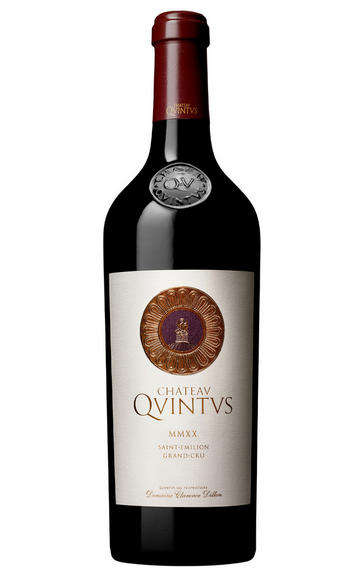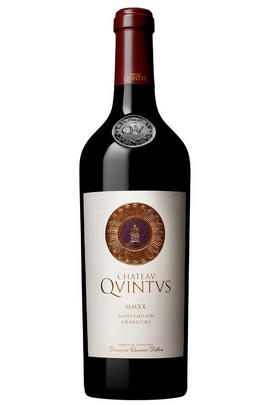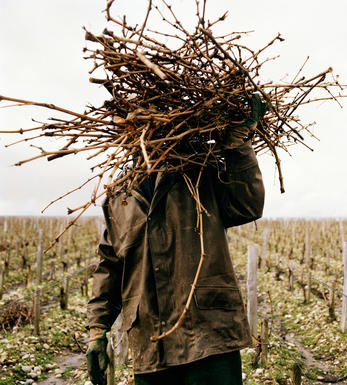
2021 Château Quintus, St Emilion, Bordeaux

Critics reviews
The 2021 Quintus is the most elegant wine I have ever tasted here, by a wide measure. Nearly half of this fruit is from the former Grand Pontet property, and that fruit seems to bring a measure of aromatic intensity and freshness these wines have lacked in some vintages. All the elements are so well balanced. Bright saline notes linger on the finish. This is impressive for the year.
Drink 2031 - 2046
Antonio Galloni, Vinous.com (May 2022)
Cask sample. Juicy, fruity, and much less obviously tart than Dragon 2021. Though a tad pinched on the end. Minerally and chewy on the end.
Drink 2025 - 2035
Jancis Robinson MW, JancisRobinson.com (June 2022)
A blend of 70% Merlot and 30% Cabernet Franc, the 2021 Quintus delivers a vibrant bouquet with aromas of dark berries, plums, cassis and spices, followed by a medium to full-bodied palate that's layered and lively, built around powdery tannins and concluding with a saline, sapid finish. Given the characteristics of the vintage, this wine stands out as a remarkable achievement, rivalling some more heralded years at this address.
"It's simple, really," explains Jean-Philippe Delmas. "We produce the Saint-Émilion de Quintus from sandy soils on the plain, the Dragon de Quintus from colluvial soils at the bottom of the slope and Quintus itself from the limestone hillside. In Burgundy, we'd call them our village, premier cru and grand cru bottling, but in Bordeaux—and it doesn't sound as good!—we call them our third, second and first wines." Quintus itself spans some 32 hectares, assembled with the acquisition of châteaux Tertre Daugay, L’Arrosée and, more recently, Grand Pontet. Delmas describes the challenge of the low-pH wines of Saint-Émilion's slopes as being how to deliver supple and integrated tannins without picking too ripe or having too oxidative an élevage. As the adventure continues, the 2021s show an assured hand—and plenty of promise.
William Kelley, Wine Advocate (February 2024)
68.2% Merlot, 31.3% Cabernet Franc and 0.5% Malbec.
Extremely focused and refined, with firm tannins that run the length of the wine. Medium-bodied with lovely length and juiciness. Blackberry and earth with mushroom and bark. Hints of orange peel, too.
James Suckling, JamesSuckling.com (May 2022)
Fragrant, perfumed strawberries and red cherries on the nose, have a sweet note to them, so welcoming, really bursting out of the glass. Smooth but also quite sharp on the palate with a rush of red fruits - cherries, raspberries, redcurrants and plums fill the palate - with mouthwatering acidity balanced by touches of wet stone minerality, iodine, graphite and pencil. You definitely get the feeling of the terroir here in the chalky saltiness, as well as the stalky, bramble, spiced Cabernet Franc giving backbone and direction. Quite a bit of smoked cedar spice comes in on the end, just overshadowing the brightness and overall sense of fun to this. Well worked with promise.
Drink 2025 - 2040
Georgina Hindle, Decanter.com (April 2022)
About this WINE

Chateau Quintus
The Clarence Dillon family company acquired a beautiful estate in Saint-Emilion, and renamed it Château Quintus. An exceptional terroir that has been recognised as such for centuries. The estate naturally wraps around a high promontory which represents the end of the plateau of Saint-Emilion. The vineyard benefits from a majestic panarama extending towards the neighbouring village and across the entire Dordogne valley. It is in the place that, for time immemorial, a watch tower has stood to ensure the defence of the village of Saint-Emilion.
The originality of this extraordinary terroir lies in its diversity of soils, slopes and orientations. It is therefore hardly surprising that this wine was featured between 1844 and 1848 - under its old name Château Tertre Daugay - among the 14 most sought after and most expensive wines of Saint-Emilion. For close to a century the great reference book Cocks and Feret "Bordeaux et ses Vins" will consistently mention the property as a First Growth of Saint -Emilion. The vineyard was also one of the prominent Saint-Emilion estates to receive a gold medal at the Exposition Universelle de Paris in 1867.
A text found in another great book of the time "Les Grands Vins de Gironde" de Dumas et Lallemand (1899) reads "One can not imagine a more beautiful situation for an estate, or one more favourable for the production of a First Growth wine (...) Thanks to the excellent vinification practices undertaken at the estate, the wine produced here reflects great body, ripeness and an armature that exemplify the great wines of Saint-Emilion."
This wine takes its natural place alongside the red and white wines of Château Haut-Brion and Château La Mission Haut-Brion, thereby becoming the 5th child in this illustrious family.

St Émilion
St Émilion is one of Bordeaux's largest producing appellations, producing more wine than Listrac, Moulis, St Estèphe, Pauillac, St Julien and Margaux put together. St Emilion has been producing wine for longer than the Médoc but its lack of accessibility to Bordeaux's port and market-restricted exports to mainland Europe meant the region initially did not enjoy the commercial success that funded the great châteaux of the Left Bank.
St Émilion itself is the prettiest of Bordeaux's wine towns, perched on top of the steep limestone slopes upon which many of the region's finest vineyards are situated. However, more than half of the appellation's vineyards lie on the plain between the town and the Dordogne River on sandy, alluvial soils with a sprinkling of gravel.
Further diversity is added by a small, complex gravel bed to the north-east of the region on the border with Pomerol. Atypically for St Émilion, this allows Cabernet Franc and, to a lesser extent, Cabernet Sauvignon to prosper and defines the personality of the great wines such as Ch. Cheval Blanc.
In the early 1990s there was an explosion of experimentation and evolution, leading to the rise of the garagistes, producers of deeply-concentrated wines made in very small quantities and offered at high prices. The appellation is also surrounded by four satellite appellations, Montagne, Lussac, Puisseguin and St. Georges, which enjoy a family similarity but not the complexity of the best wines.
St Émilion was first officially classified in 1954, and is the most meritocratic classification system in Bordeaux, as it is regularly amended. The most recent revision of the classification was in 2012

Merlot/Cabernet Franc
Merlot and Cabernet Franc are grape varieties commonly used in Bordeaux-style blends, particularly in the Bordeaux region of France. When these two grapes are blended, they can create a wine that combines the best characteristics of each variety.
Merlot is known for its smoothness, soft tannins, and ripe fruit flavours. It often contributes black cherry, plum, and chocolate flavours to the blend. The grapes are relatively easy to grow and ripen earlier than other Bordeaux varieties, making them versatile for blending.
Cabernet Franc, on the other hand, adds structure, depth, and complexity to the blend. It typically brings aromas of red fruits such as raspberry and strawberry, along with herbal notes like bell pepper and tobacco. These grapes have thinner skins and can be more challenging to cultivate, requiring specific growing conditions to reach their full potential.
When Merlot and Cabernet Franc are combined, the result is a well-balanced wine with various flavours and aromas. The blend often exhibits a Bordeaux wine's medium to full body, along with a smooth texture and moderate tannins. The specific flavour profile can vary depending on the proportions of each grape in the blend and the terroir and winemaking techniques employed.


Buying options
Add to wishlist
Description
Merlot 70%, Cabernet Franc 30%.
The name Château Quintus denotes the fifth born. This is the latest addition to the impressive Domaine Clarence Dillon stable, comprising wineries including Châteaux Haut-Brion and La Mission Haut-Brion. It is safe to say the wine has a strong pedigree. The 2021 shows great freshness and future drinkability, with some pleasing generosity. For now, it’s tightly packed, and the fruit has a dark quality to it, dominated by blackberry and coffee notes. This should start to show complexity and opulence in five years or so.
Drink 2026 - 2040
Our score: 16/20
Berry Bros. & Rudd
wine at a glance
Delivery and quality guarantee